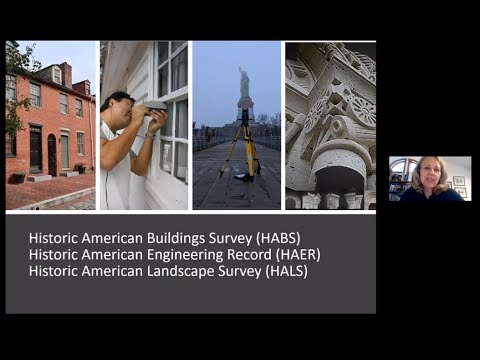Introduction to the Heritage Documentation Programs (HABS/HAER/HALS)

hello i'm catherine lavoy i'm chief of the historic american building survey or habs as we are better known and i want to tell you a little bit about our programs and our partner programs the historic american engineering record historic american landscape survey what we do and how and why we got started and why our programs are so important habs was the first ever federal historic preservation program and thus it laid the groundwork for many of the other programs that followed establishing concepts and methodologies that are now standard practice these include the notion of going into the field to conduct architectural surveys identifying and developing listings of important resources and preparing documentation of those resources for the public benefit the first habs surveys were undertaken as part of a temporary federal make work program by architects like those you see on the right who scoured the countryside looking for worthy candidates for recording they produced their listing in the form of the index cards as you see here on the left identifying about seven thousand buildings worthy of documentation just in the first couple years haves was actually created in a perfect storm of events that combined a budding interstate interest in historic preservation through initiatives such as colonial williamsburg the colonial revival movement in general that fostered a desire to collect and preserve records artifacts and even buildings from our colonial past and the need to create jobs park service architect charles peterson whose picture down here in the lower left heeded the call by this secretary of interior for make work programs and wrote the proposal that outlined the habs program in 1933 but it was this man lester holland curator of fine arts at the library of congress and the head of what is now known as the historic resources committee of the aia who enabled the program to hit the ground running holland rallied his state and local members as habs district officers overseeing the surveys in the field holland then became the first curator of the collection only intended to last a couple months interest in the documentation was overwhelming thus haves was made permanent in 1934 through an unusual partnership that spans both public and private sectors and both the legislative and executive branches of government to include the national park service the library of congress and the american institute of architects under the terms of the agreement the national park service administers the program with a staff of architects historians and photographers creating documentation the library of congress houses the collection under state-of-the-art conditions and makes it available to the general public via their website copyright free the aia provides advice and guidance through the lens of private sector practice making recommendations for the investigation of new technologies and supporting program initiatives essentially habs was a call to action a response to the needs recognized within all three partnering organizations to preserve for future generations our nation's vanishing architectural heritage through documentation that need is just as relevant today if not more so threatened not just by development and neglect as was the case in the 1930s but now through climate change and increased natural disasters this example of an early maryland chesapeake style house recorded in the 1930s after it was already abandoned as shown in the center image and revisited in the 1990s with only the brick walls left standing as shown here on the right speaks to the need for timely recording habs was essentially a call to action a response to the need recognized within all three of those partnering organizations to preserve for future generations our nation's vanishing architectural heritage through documentation that was that was just what was needed it's just as relevant today as it was then buildings threatened by neglect as was the case in the 1930s but nowadays they're also threatened through climate change and increased national natural disasters this example of an early maryland chesapeake style house recorded in the 1930s as it was already abandoned and beginning to sag was revisited in the 1990s with only the brick and walls left standing this speaks to the need for timely recording endangered architecture was a priority back then in the 1930s and it remains so today tabs also marked the first time that historic resources were recorded comprehensively on a national scale and to uniform standards so prior to habs architects were creating folio volumes of drawings of historic buildings within their particular region as seen on the example on the right but they usually included only drawings sometimes photographs but very rarely any historical information that was contrary to the habs documentation that you see here on the left which combines photographs drawings and historical reports to get a comprehensive understanding of the building the fact that the have surveys were national also enabled analysis on a broader perspective than ever could have been achieved before if you could imagine a world before the national register or even before architectural history was recognized as a separate field architects historians could begin to identify building typologies basic building plans and forms like the cape cod and salt boxes that you see here taken from the early habs records once identified they could then trace their diffusion and the spread of architectural ideas from one region to the next habs was also seen as a potential source for period-appropriate building designs and architectural elements that could be used to inform restoration projects early preservation initiatives counted on such work and it is exactly what the architects of colonial williamsburg were doing creating drawings of early buildings in their region as a reference to develop a better understanding of the architecture of the period likewise the habs records could be used in the design of colonial revival style buildings selecting any number of period motifs from the have's archive but probably the reason that have survived for over 80 years is the value and timelessness of the basic underlying principle as conceived and written in the initial proposal habs was to represent a complete resume of the building arts that meant architect design buildings as well as the vernacular and utilitarian to include everything from the ubiquitous log settlers cabin seen here to the urban skyscraper also represented in the collection was a wide array of regionally and ethnically derived building forms everything from native american pueblos to spanish missions and southern creole plantations to name just a few haves also recorded humble buildings they invoke the lives of everyday people from past generations such as the colonial kitchen and the old general store pictured here also buildings and sites significant for their association with important persons and events such as the lincoln memorial and social movements such as labor history and civil rights as represented here by the 16th street baptist church were also recorded this was done in an effort to tell all american stories abs was underpinned by the passage of the 1935 historic sites act the act called for the national park service to quote secure collate and preserve drawings and other historic sites buildings and objects a clear reference to the work that habs had already begun likewise with the national historic preservation act of 1966 it mandated that historic sites negatively impact or lost through development projects undertaken with federal funds be mitigated through documentation to have standards thus creating a lasting record today the collection at the library of congress includes documentation on over 44 000 sites it can be queried by building type style or region as well as by terms related to function ethnic groups or social or cultural ideas the website receives approximately fifty 000 visitors a month with k-12 students and educators being the largest user group while haves believes that the preservation of historic sites is important as a mean of pro means of providing tangible evidence of the nation's architectural achievements as well as important persons and events the program founders recognize that all not all buildings could be saved to ensure that they don't quote pass into unrecorded oblivion the documentation provides just that record interested private sector constituency responsible for habs was matched in 1969 by the creation of our companion program the historic american engineering record or hair when five engineering side societies the national park service and the library of congress signed a similar tripartite agreement tabs has recorded sites such as textile mills gold mines electrical power plants dams maritime vessels nasa rocket test stands and the iconic cover bridge while habs was recording industrial sites prior to hair's development such as the building that you see here on the left of an old tide mill in new england hare recognized that a particular constituency expanding to include larger industrial complexes as well as process drawings that help make industrial and engineering concepts understandable to the layperson likewise in 2000 with the creation of the historic american landscape survey or hals in partnership with the american society of landscape architects to record important historic landscapes these two range in scope from park lands to formal gardens including sites such as historic ranches in the grand canyon to a sacred hawaiian hayao and even world war one american cemeteries abroad once again haves had recorded some formal design landscapes such as the picture of the garden that you see on the far left but howls acknowledge cultural as well as formal landscapes and the fact that landscapes are different from buildings requiring new approaches and new recording methods now known collectively as the heritage documentation programs the mission of have zero house today is multi-faceted of course first and foremost is the generation of documentation for the library of congress collection the programs engage in agreements with other federal agencies and the private sector to create documentation that it serves as baseline information for rehabilitation and interpretation of historic resources recent projects include the statue of liberty an ellis island immigration station the tidal basin in washington dc and the nasa space shuttle the programs serve as a clearinghouse for documentation created to standards generated by others as well for over 60 years we have also trained the next generation of preservationists through a summer recording program teams of student architects and historians work on the direction of the washington office measuring and drawing research and writing about significant resources the programs also support various prizes for measured drawings and for historical reports to encourage student and professional involvement as the lead federal agency for documentation the programs also develop guidelines and standards that comply with the requirements outlined in the secretary of the interior's guidelines for architectural engineering and landscape documentation at the same time the programs create standard setting documentation for example hare is currently working with the historic vehicle association to record some of the most important and path-breaking automobiles in american society such as the car that won the very first indy 500 pictured up here the 1911 marmot wasp in the process hair developed a prototypical design for historical reports that address the particular qualities of automobiles while all three programs have their individual guidelines for the different disciplines more recently habs developed guidelines specifically for students and non-professionals as shown here on the screen it's a more basic how-to that walks students through the measuring process while also helping them to learn to read a building and become more observant so they can record the knowledge game through their field experiences finally the programs routinely explore new recording methodologies and technologies to keep current with best practices our methodology still incorporates traditional hand measuring particularly within the context of our students summer program we believe that the best way to learn about historic buildings is to engage with them there's no substitute for careful examination of the artifact itself and this is perhaps best achieved by actually measuring and describing its salient features in detail it's through this process the researcher begins to understand how a building was directed and later evolved noting its plan construction technology and stylistic details that hint at its development and the time frame for its it's also through such an examination that variations suggesting change over time are generally observed we do however bring a laser scanner to virtually every site as an accurate and effective means of collecting data today the laser scanner does though however have its drawbacks it cannot record elements that are out of its range or obscured by other buildings or foliage it is also not the best at recording details due to due to the pixelated nature of the point cloud details are often best recorded through an old-fashioned profile comb or through photogrammetry which is particularly effective in recording details and statuary as you can see here the architects are taking pictures dozens of which will be overlaid to create a complex 3d model representation that can be migrated into the computer aided software in addition to our guidelines the secretary of the interior standards deal with the underlying principles behind the documentation demanding clarity verifiability and most importantly long-term term stability it's for these reasons that have hair house pushes back against the so-called scan and can or solely digital documentation projects laser scanning technology requires very specialized equipment software and understanding that's why our final product is the measured drawing on vellum rather than just the scans alone only drawings can guarantee a lasting record while being of use to our main constituency that being the general public you can go on our website and look more carefully at these images that show the pros and cons of laser scanning while i'd never argue against the value of digital materials that have revolutionized our learning environments the storage and longevity of digital materials has always been a moving target as suggested by some of the now antiquated equipment and computer disks pictured here on the left it's a problem with no easy and cost effective solution the storage of digital materials is 10 times that of paper records or the negative as shown here this can be a problem in the future when we determine how best to spend our limited preservation dollars so our our workflow as outlined here is including the migration of scanned and photogrammetric data overlaid often with photographic images into the computer-aided software to produce the final measured drawing that you see here on the right hdp also uses gps technology to record actual site locations and to register laser scan and photogrametric data in this example gps units were used to map the extensive landscape of taisei ranch in the grand canyon where there is no street address and where the buildings are quickly vanishing as a byproduct of all this digital technology hdp is also able to produce digital animations although not part of the formal collection at the library of congress they are useful for interpretive and educational purposes users can now visit sites such as ellis island or the totem pole trail in sitka national historical park in alaska or the ainmar american cemetery in france virtually from their home through the hdp exhibition page or our youtube channel our documentation is also used to create interactive story maps populated with drawings and photographs and 3d models with information from the historical report used as text and historic images identified through the research process included the documentation is generally used as baseline information and maintenance of historic structures such as this these images of ellis island where we're recording that part of the island that is no longer accessible and is currently endangered due to the high quality of the documentation it is also used frequently in books scholarly journals and other publications no permissions are necessary the documentation is also used for advocacy to create awareness and appreciation for the nation's architectural engineering and landscape legacy this is just one example of habs documentation used to alert the baltimore community about its endangered central business district in another instance habs partnered with the local community groups in philadelphia to bring attention to a neighborhood at risk recording various row house forms building the city was tearing down to create room for new development and identifying community landmarks those buildings that resonate with everybody a walking tour was developed to highlight the neighborhood's asset as well as an exhibition and lecture series as mentioned the documentation is used to interpretation providing accurate information through the research process to develop the historical and architectural context in which the site was created and later evolved habs is often called upon to develop the true evolution dispelling many myths that are circle historic buildings in this case we actually created a docents guide for the john bartram house where we were asked to visit more generally speaking we record our build environment because it reflects who we are and what we value it can represent the greatest accomplish accomplishments both from an aesthetic and a technological standpoint whether it's striving for new heights inspiring better living providing healthy environments or creating social change in closing i just want to say that there are lots of ways that students and other interested individuals can participate in the habs process and crit and contribute to the collection in fact we can't be everywhere and so we count on others to help i already mentioned the charles e peterson prize for the best set of measured drawings undertaken by a student group to have standards here are some of the peterson prize posters that can show you the wide range of building types that have been drawn by student groups student involvement is also a great way to keep the collection balanced by ensuring that it continues to represent a broad range of building types from all parts of the country we want to hear from you about what you think is important about your corner of the world as represented through drawings student contributions are often some of the most intriguing submissions that we get likewise is the lester b holland prize created to encourage professional involvement but is open to all groups and has in fact drawn equally from student and professional involvement the holland prize asks for a single sheet measured drawing challenging the delineator to represent the building by depicting its most salient features while also invigorating the art of composition with either of these competitions we can help you by answering questions and providing review and critique of the drawings you can also create a short format report with digital digital photographs used as figure pages this is a really quick and easy way to contribute to the collection and it can be added on with more information at a later time in fact the house problem pro excuse me the house program offers a competition for the best short report of an historic landscape selecting a different theme each year for more information about the habs hair and house programs please go to our website check our facebook page or our youtube page or simply browse the library of congress collection online thank you for our time and i hope that we hear from you in the future
2021-03-28 22:29


